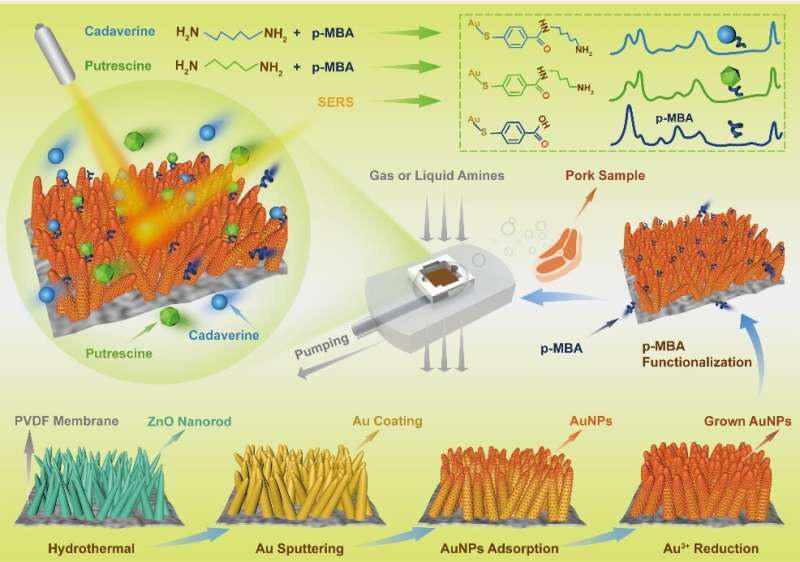A highly sensitive SERS substrate for gas sensing

Trace gas sensing is critical for monitoring environmental pollution and detecting volatile organic compounds released from the human body. As a powerful analytical tool for identifying trace molecules, surface-enhanced Raman spectroscopy (SERS) enables remarkable amplification of normal Raman signals by using the surface plasmon resonance effect and charge-transfer effect with excellent sensitivity, noninvasive detection capability, and unique fingerprint effect, and it has been widely used in the field of analysis, especially for gas sensing.
Prof. Zhang Zhiqiang and Dr. Sun Jiaojiao from the Suzhou Institute of Biomedical Engineering and Technology (SIBET) of the Chinese Academy of Sciences (CAS) have recently developed a highly sensitive three-dimensional (3D)-rosettelike SERS substrate (BigAuNP/Au/ZnO/P).
The SERS substrate was made by a combination of the merit of the 3D morphology of ZnO nanorod arrays on a flexible porous poly (vinylidene fluoride) (PVDF) membrane and the in situ chemical growth of Au nanoparticle seeds on the Au film-coated ZnO nanorods, which produced a 3D-rosettelike BigAuNP/Au/ZnO/P heterostructure with abundant SERS-active hotspots that significantly enhanced localized surface plasmon resonance effect and charge-transfer effect of Raman enhancement.
Using p-mercaptobenzoic acid (p-MBA) as probe molecules with a concentration down to 10-13 M, the SERS substrate presented an enhancement factor as high as 2.27 × 107 with excellent uniformity and reproducibility.
More importantly, the porous structures of the PVDF membrane can facilitate the interaction of "hot spots" with analytes and assist the selective detection of a gaseous target in a complex environmental condition.
The researchers selected putrescine and cadaverine to verify the practicability of the 3D flexible SERS substrate in gas sensing. Using p-MBA molecular monolayer as the sensing interface, gaseous putrescine and cadaverine were selectively captured by amide reaction at low concentration (putrescine: 1.26 × 10-9 M; cadaverine: 2.5 × 10-9 M), the detection limit was two to three orders of magnitude lower than that reported before, indicating the good gas sensing performance of this SERS substrate.
Using its flexibility, porosity, and excellent SERS performance, this 3D flexible substrate can be integrated with microfluidic devices and portable Raman spectrometers to construct on-site SERS detection system.
Such a system is expected to enable efficient capture and enrichment of bacteria, viruses, and pollutants in aerosols for applications including food quality determination, environmental monitoring, and disease diagnosis.
Relevant results have been published in Analytical Chemistry, titled "Ultrasensitive SERS analysis of liquid and gaseous putrescine and cadaverine by a 3D-rosettelike nanostructure-decorated flexible porous substrate."
More information: Jiaojiao Sun et al, Ultrasensitive SERS Analysis of Liquid and Gaseous Putrescine and Cadaverine by a 3D-Rosettelike Nanostructure-Decorated Flexible Porous Substrate, Analytical Chemistry (2022). DOI: 10.1021/acs.analchem.1c05013
Journal information: Analytical Chemistry
Provided by Chinese Academy of Sciences


















